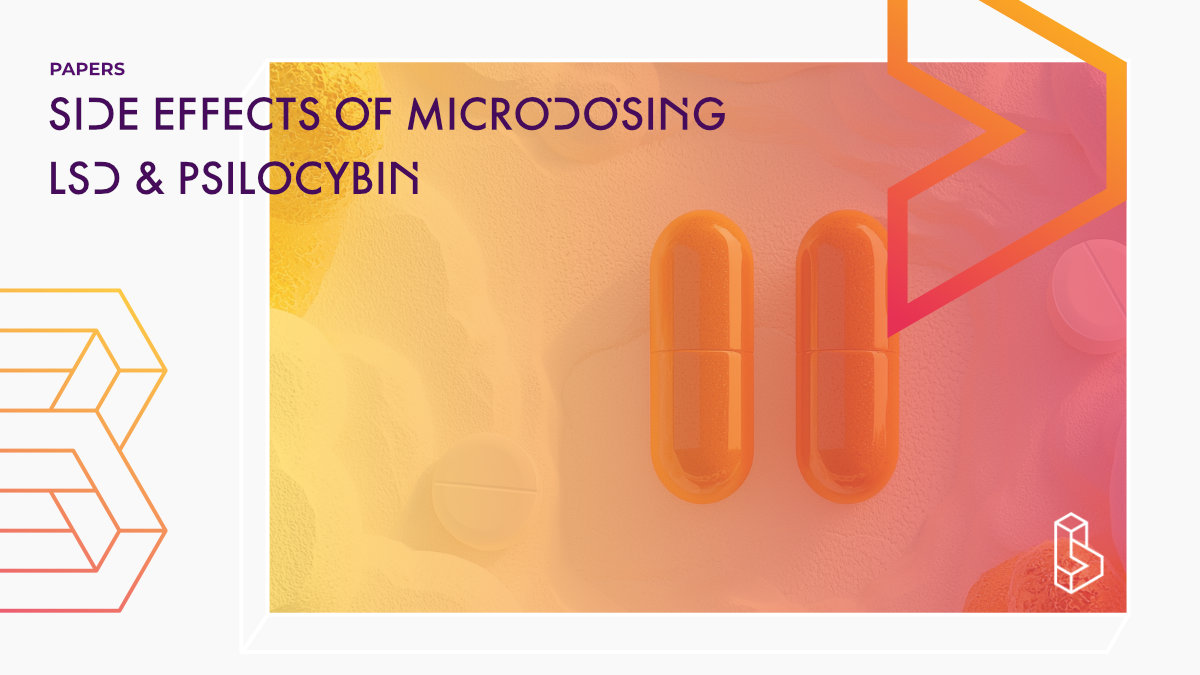This systematic review (s=31) examines the side effects of microdosing LSD and psilocybin, finding that adverse effects are typically dose-dependent, mild, and short-lived. Common side effects include increased blood pressure, anxiety, and cognitive impairment. The review highlights the lack of standardised reporting on side effects and calls for future studies to provide more systematic and transparent assessments.
Abstract of Side Effects of Microdosing Lysergic Acid Diethylamide and Psilocybin
“Objective Psychedelics are gaining renewed attention, especially through the practice of microdosing, where low doses are taken regularly. Microdosing lysergic acid diethylamide (LSD) and psilocybin is used by both healthy individuals and those with mental health conditions to improve daily functioning, reduce anxiety, and enhance mood and cognition. However, there is limited information about the side effects of this practice. This review aimed to collect and characterize the side effects of psychedelic microdosing.
Methods We conducted a systematic review of original papers from PubMed, Web of Science, and Scopus (accessed August 03, 2024) that reported side effects of microdosing LSD and psilocybin. Non-English papers, non-original studies, studies without typical microdosing doses, or those lacking descriptions of side effects were excluded. Our methodology has been developed in accordance with PRISMA guidelines. Because side effects were assessed heterogeneously in these papers, we did not perform a bias evaluation.
Results We included 31 studies, 15 of which we classified as laboratory studies with higher quality evidence, and 14 studies with lower quality evidence, as well as 2 clinical cases. Side effects were typically dose-dependent, mild, and short-lived. Common adverse effects included increased blood pressure, anxiety, and cognitive impairment.
Discussion This review is limited by the heterogeneity in reporting side effects and the short duration of many studies. Future studies should transparently and systematically present a description of side effects.“
Authors: Stefan Modzelewski, Anna Stankiewicz, Napoleon Waszkiewicz & Kacper Łukasiewicz
Summary of Side Effects of Microdosing Lysergic Acid Diethylamide and Psilocybin
Background
Psychedelics have been studied for decades due to their potential impact on mental health and cognitive functioning. Although early research suggested promising effects, political and regulatory restrictions in the 1970s led to a decline in scientific investigations. In recent years, there has been renewed interest in their therapeutic potential, particularly for conditions such as depression, anxiety, and post-traumatic stress disorder. This renewed focus has led to policy changes, including the decriminalisation of psilocybin in some jurisdictions and its medical approval for PTSD treatment in Australia.
One of the most discussed practices in the psychedelic resurgence is microdosing, which involves taking very low, sub-hallucinogenic doses of psychedelics such as lysergic acid diethylamide (LSD) or psilocybin on a scheduled basis. Advocates claim that microdosing enhances mood, cognitive function, and creativity while reducing symptoms of anxiety and depression. Despite widespread anecdotal reports and growing interest in microdosing, scientific evidence regarding its benefits and risks remains limited. The most significant gap in the literature concerns potential side effects, which this systematic review aims to address.
Definition of Microdosing
Microdosing typically involves consuming around one-tenth to one-twentieth of a full psychedelic dose, aiming to produce subtle cognitive and emotional benefits without perceptual distortions or hallucinations. The most common approach, known as the Fadiman method, consists of taking a dose every third day. Other regimens involve dosing every second day, following a cycle of daily intake with scheduled breaks, or taking doses based on personal intuition.
Find this paper
https://doi.org/10.1016/j.neuropharm.2025.110402
Open Access | Google Scholar | Backup | 🕊
Cite this paper (APA)
Modzelewski, S., Stankiewicz, A., Waszkiewicz, N., & Łukasiewicz, K. (2025). Side Effects of Microdosing Lysergic Acid Diethylamide and Psilocybin: A Systematic Review of Potential Physiological and Psychiatric Outcomes. Neuropharmacology, 110402.
Study details
Compounds studied
LSD
Psilocybin
Topics studied
Microdosing
Study characteristics
Meta-Analysis
Participants
1947
Humans

